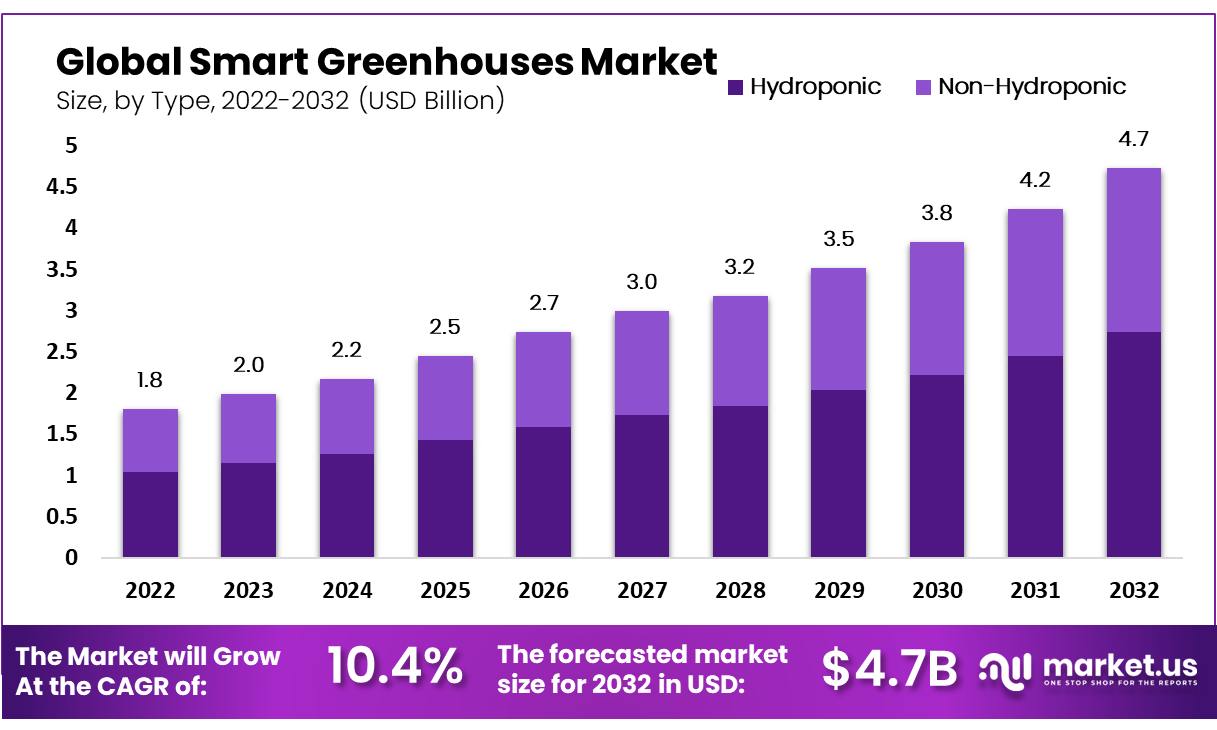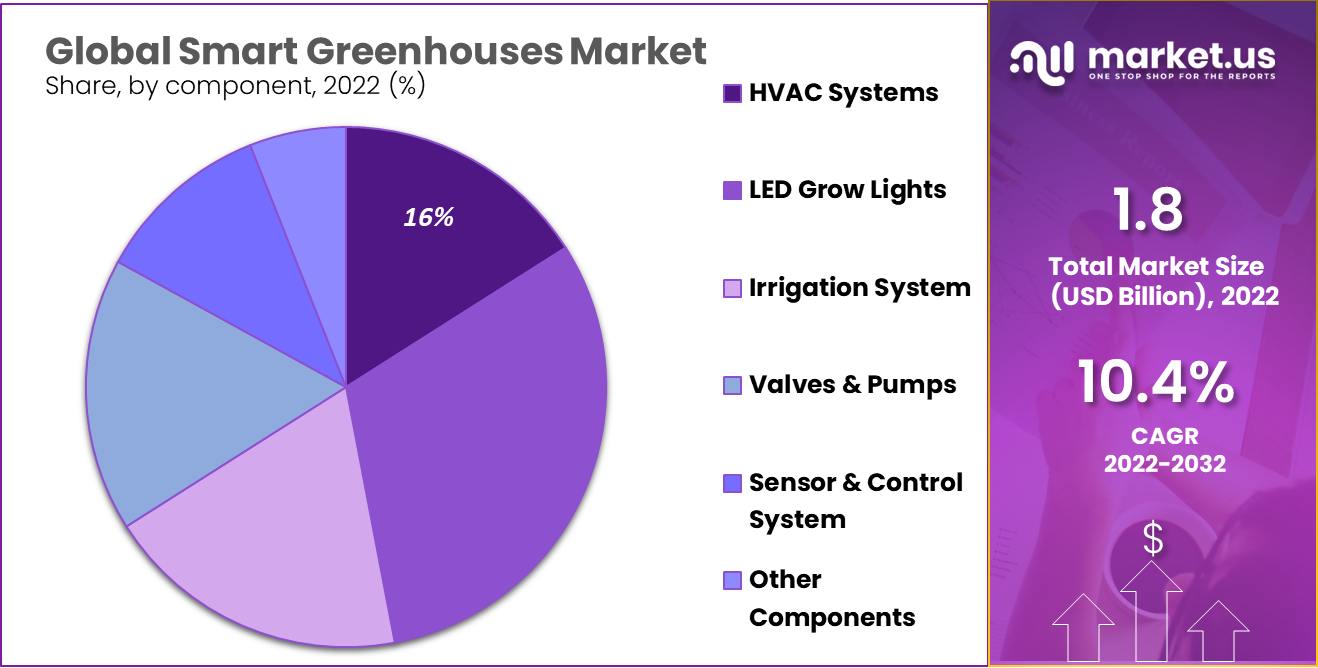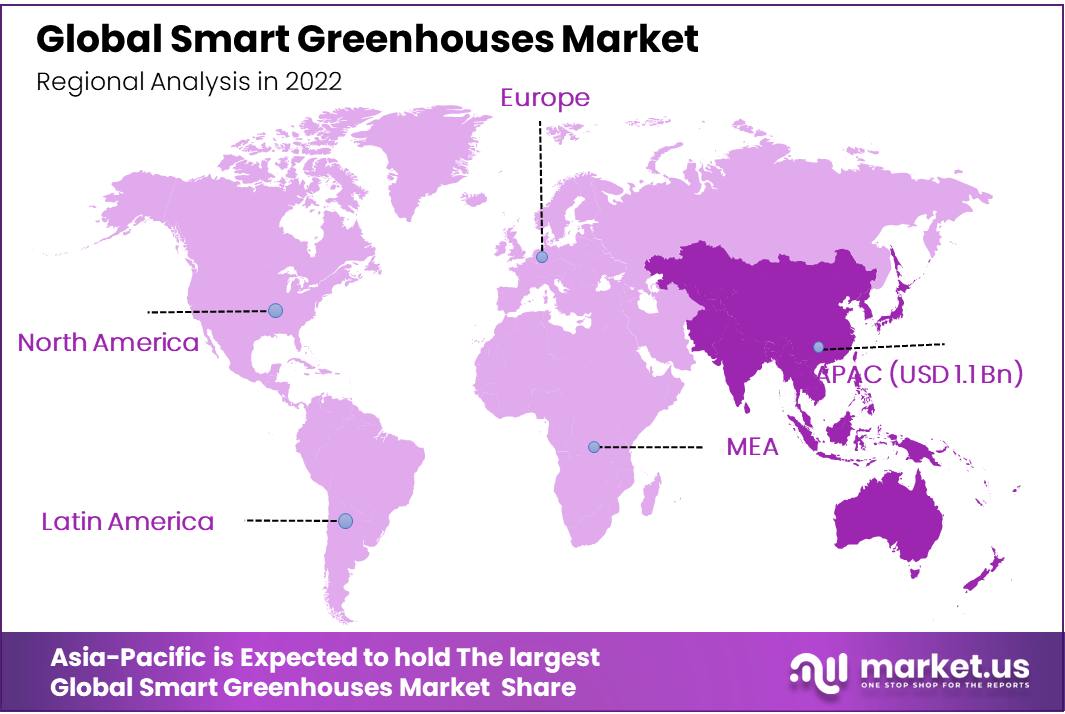Global Smart Greenhouses Market By Type (Hydroponic, and Non-Hydroponic), By Technology (HVAC Systems, LED Grow Lights, Irrigation Systems, Valves & Pumps, Sensor & Control Systems, and Other Components), By End-User (Commercial Growers, Research & Educational Institutes, Retail Gardens, and Other End-Users), By Region and Companies - Industry Segment Outlook, Market Assessment, Competition Scenario, Trends, and Forecast 2023-2032
- Published date: Sep 2023
- Report ID: 106884
- Number of Pages: 301
- Format:
- keyboard_arrow_up
Quick Navigation
Report Overview
In 2022, the global smart greenhouses market was valued at USD 1.8 billion, and is expected to reach USD 4.7 Billion in 2032 Between 2023 and 2032, this market is estimated to register a CAGR of 10.4%.
Introduction
Smart greenhouses are advanced agricultural facilities designed to optimize plant growth and enhance crop production while minimizing resource consumption and environmental impact. These innovative structures integrate various technologies to create a controlled environment that can be remotely monitored and adjusted.
Smart greenhouses often employ sensors to measure factors like temperature, humidity, light, and soil moisture, allowing for real-time data analysis. Additionally, automated systems can regulate climate conditions, irrigation, and nutrient delivery, ensuring ideal growing conditions for plants. The smart greenhouses market has witnessed remarkable growth in recent years.
This expansion can be attributed to a variety of factors, including the increasing global population’s demand for fresh produce, the need for sustainable agricultural practices, and advancements in technology. Smart greenhouses offer innovative solutions to address these challenges.
Key Takeaways
- The Global Smart Greenhouses Market is valued at USD 1.8 Billion in 2022.
- By Type, the Hydroponic segment dominated the global smart greenhouses market with a market share of 58% in 2022.
- By Component, the LED Light Grows segment dominated the global smart greenhouses market with more than 31% of the market share in 2022.
- By End-User, the Asia–Pacific region was the dominant region in the global smart greenhouses market, with a market share of 32.5% of global revenue.
- The largest greenhouse in the US is located in Morehead, Kentucky, and is operated by AppHarvest, which uses artificial intelligence and robotics to grow up to 45 million pounds of tomatoes annually.

Actual Numbers Might Vary in the Final Report.
Driving Factors
Advancements in Agricultural Technology
The global smart greenhouses market is experiencing robust growth, driven by several compelling factors. One of the primary drivers is the continuous advancements in agricultural technology. Farmers and growers worldwide are increasingly adopting smart greenhouse systems to optimize their crop production.
These technologies include automated climate control, precision irrigation systems, and sensor-based monitoring, among others. As the agricultural sector seeks to enhance productivity and reduce resource consumption, the demand for smart greenhouses continues to rise.
This driver underscores the pivotal role of technology in modernizing agriculture and ensuring food security for a growing global population.
Environmental Sustainability Imperatives
Another pivotal driver propelling the growth of the global smart greenhouses market is the increasing emphasis on environmental sustainability. As concerns about climate change and resource scarcity mount, smart greenhouses offer a sustainable solution to traditional farming practices.
These greenhouses enable more efficient resource utilization by optimizing water, energy, and fertilizer use. Additionally, their controlled environments reduce the need for pesticides and herbicides, promoting eco-friendly agriculture.
As governments and consumers prioritize sustainability, the adoption of smart greenhouses is poised to accelerate, making them a cornerstone in the transition toward a greener and more sustainable agricultural future.
Restraining Factors
High Initial Investment Costs
One of the primary restraints impeding the growth of the global smart greenhouses market is the substantial initial investment required. Implementing smart greenhouse technology involves purchasing advanced equipment such as automated climate control systems, sensors, and monitoring software.
Additionally, the construction of the greenhouse itself with the necessary infrastructure for automation and control can be expensive. This upfront capital expenditure can be a significant barrier, particularly for small and medium-sized agricultural enterprises.
Despite the long-term benefits in terms of increased yields and reduced resource consumption, many potential adopters are deterred by these high initial costs.
Technical Complexity and Maintenance Challenges
Another significant restraint in the global smart greenhouses market is the technical complexity of these systems and the associated maintenance challenges. Smart greenhouses rely on a combination of sensors, actuators, and software platforms to monitor and control environmental conditions.
This complexity can lead to difficulties in system setup and ongoing maintenance, requiring specialized knowledge and skilled personnel. Moreover, system malfunctions or software glitches can disrupt operations, leading to crop losses and financial setbacks for greenhouse operators.
Addressing these technical challenges and ensuring the reliable operation of smart greenhouse systems remains a critical barrier to widespread adoption.
Growth Opportunity
Adoption of IoT and AI
The adoption of IoT and AI presents and promising opportunity in the global smart greenhouses market. One significant advantage of this technology is its ability to create a controlled and optimized environment for plants.
AI algorithms can analyze historical data and adjust various parameters automatically to create the ideal conditions for specific crops. For instance, if the AI system detects that a particular crop requires higher humidity levels, it can activate misting systems or adjust ventilation accordingly, without the need for constant human intervention.
Moreover, IoT and AI can enhance resource efficiency in greenhouse farming. By monitoring and controlling resource usage, such as water and energy, growers can reduce waste and lower operational costs. For example, AI-powered systems can predict when plants will require irrigation based on soil moisture levels, weather forecasts, and plant growth stages, thus preventing overwatering.
Additionally, the integration of IoT and AI in smart greenhouses can lead to better pest and disease management. Sensors can detect early signs of infestations or diseases, and AI algorithms can provide immediate alerts to growers, allowing for timely intervention. This proactive approach can significantly reduce crop losses and the need for chemical pesticides.
Latest Trends
Solar Smart Greenhouses
One notable trend in the global smart greenhouses market is the increasing adoption of solar energy solutions. Smart greenhouse operators are turning to solar power to fulfill their energy requirements, which not only reduces greenhouse gas emissions but also trims operational expenses.
Solar panels are being strategically placed on greenhouse rooftops to harness clean, renewable energy from the sun. This harvested energy is efficiently utilized to power various greenhouse systems such as heating, cooling, and lighting. Moreover, surplus energy can be stored in batteries for use during overcast days or at night, ensuring an uninterrupted power supply.
This adoption of solar technology aligns perfectly with the global push for sustainability and a reduction in carbon footprints. It not only enhances the environmental friendliness of smart greenhouses but also augments their energy independence, reducing dependence on conventional energy sources.
Type Analysis
Based on type, the global smart greenhouses market is segmented into Hydroponic and Non-Hydroponic. Among these types, the hydroponic segment is the most lucrative in the global smart greenhouses market, with a market share of 58%, in 2022. Hydroponic systems allow for precise control over the nutrient and water supply to plants.
This level of control maximizes resource utilization, reducing water consumption and minimizing nutrient waste. Moreover, these systems enable year-round cultivation, irrespective of seasonal changes. This ability to grow crops continuously is essential for meeting the increasing demand for fresh produce throughout the year.
Additionally, hydroponic setups are typically less susceptible to pests and diseases compared to traditional soil-based cultivation. This is because the absence of soil reduces the habitat for many common plant pests and pathogens.
Component Analysis
Based on components, the global smart greenhouses market is segmented into HAVC systems, LED Grow Lights, Irrigation Systems, Valves and pumps, Sensor and Control Systems, and Other Components. The LED grow lights segment is estimated to be the most lucrative segment in the global smart greenhouses market, with a market share of 31%, in 2022.
LED grow lights are known for their exceptional energy efficiency. They consume significantly less power compared to traditional lighting systems like high-pressure sodium (HPS) lights. This efficiency translates into reduced operational costs for greenhouse owners. Moreover, LED grow lights allow growers to customize the light spectrum emitted by the fixtures.
This feature enables them to tailor the lighting conditions to the specific needs of different crops and growth stages, optimizing plant growth and yield. Additionally, LED lights have a longer lifespan than traditional lighting technologies. They can operate for tens of thousands of hours before needing replacement, reducing maintenance expenses and downtime.

Actual Numbers Might Vary in the Final Report.
End-User Analysis
Based on end-users, the global smart greenhouses market is segmented into Commercial Growers, Research and Educational Institutes, Retail Gardens, and Other End-Users. Among these end-users, the research & educational institutes segment is estimated to be the most lucrative segment in the global smart greenhouses market, with a market share of 32.5%, in 2022.
Research and educational institutes, including universities and agricultural research centers, often receive substantial funding for greenhouse projects. Governments and private organizations recognize the importance of research in improving agricultural practices and sustainability.
Moreover, educational institutions have access to a pool of talented researchers, scientists, and students who are interested in advancing greenhouse technologies. Their expertise and dedication contribute to the development and adoption of smart greenhouse solutions.
Market Key Segmentation
Based on Type
- Hydroponic
- Non-Hydroponic
Based on Component
- HVAC Systems
- LED Grow Lights
- Irrigation System
- Valves & Pumps
- Sensor & Control System
- Other Components
Based on End-User
- Commercial Growers
- Research & Educational Institutes
- Retail Gardens
- Other End-Users
Geopolitics and Recession Impact Analysis
Geopolitical Factors
Geopolitics plays a crucial role in shaping the smart greenhouses market. Trade agreements, tariffs, and international relations impact the movement of technology, resources, and investments. The following are key geopolitical considerations:
- Trade Relations: Bilateral and multilateral trade agreements can facilitate or hinder the export and import of smart greenhouse technologies. Trade tensions between major economies can disrupt supply chains, affecting the availability and cost of components.
- Resource Allocation: Geopolitical conflicts can impact the supply of critical resources such as rare earth metals needed for manufacturing advanced greenhouse technology components.
- Intellectual Property Protection: Intellectual property rights and patent disputes can influence the market, affecting the development and deployment of innovative smart greenhouse solutions.
Economic Recession Impact
Recessions can significantly affect the smart greenhouses market. Economic downturns can lead to reduced consumer spending and investment, which can have the following consequences:
- Reduced Investments: During a recession, companies may cut back on capital expenditures, affecting the development and adoption of smart greenhouse technologies.
- Shift in Priorities: Economic uncertainty may lead to changes in consumer preferences and priorities, potentially affecting demand for certain agricultural products and smart greenhouse technologies.
- Supply Chain Disruptions: Recessions can disrupt global supply chains, impacting the availability of essential components and materials for smart greenhouse systems.
Regional Analysis
Asia-Pacific is estimated to be the most lucrative market in the global smart greenhouses market, with the largest market share of 60%. APAC countries have a rich history and tradition of agriculture. Many of these countries have been agrarian societies for centuries, and this expertise has naturally extended to modern agricultural practices, including greenhouse farming.
Also, many APAC governments have recognized the importance of smart greenhouse technology in ensuring food security and reducing the environmental impact of agriculture. Consequently, they have implemented policies and provided incentives to encourage the adoption of this technology.
Additionally, rapid infrastructure development in APAC has made it easier to implement large-scale smart greenhouse projects. This includes the availability of land, transportation networks, and utilities required for greenhouse operations.

Actual Numbers Might Vary in the Final Report.
Key Regions and Countries
- North America
- The US
- Canada
- Europe
- Germany
- France
- The UK
- Spain
- Italy
- Russia & CIS
- Rest of Europe
- APAC
- China
- Japan
- South Korea
- India
- ASEAN
- Rest of APAC
- Latin America
- Brazil
- Mexico
- Rest of Latin America
- Middle East & Africa
- GCC
- South Africa
- Rest of MEA
Key Players Analysis
Some key players in the global greenhouses market are Heliospectra AB, Rough Brothers Inc., Lumigrow Inc., Certhon, GreenTech Agro LLC, Argus Control System Ltd, and more. Some are focussing on innovation, and constantly upgrading their greenhouse technologies to incorporate advanced automation, AI-driven monitoring systems, and sustainable energy solutions.
Others have pursued strategic partnerships and collaborations to expand their market reach and diversify their product offerings. Additionally, many key players have prioritized sustainability by implementing eco-friendly practices and reducing carbon footprints to meet the growing demand for environmentally conscious solutions.
Market Key Players
- Heliospectra AB
- Rough Brothers Inc. (Gibraltar Industries INC.)
- Lumigrow Inc.
- Certhon
- GreenTech Agro LLC
- Argus Control System Ltd
- Hort Americans
- Greenhouse Megastore (BFG Supply)
- Netafim
- Desert Growing
- Sensaphone
- CarbonBook (Motorleaf)
- DutchGreenhouses
- Other Key Players
Recent Developments
- In Jan 2023, Dutch greenhouse construction company Bosman Van Zaal declared the completion of their high-tech greenhouse in Russia, which will be used to grow strawberries year-round.
- Meanwhile, In Feb 2023, Japanese firm Kubo Group revealed plans to construct a similar high-tech greenhouse in Japan that will supply vegetables for local markets.
Report Scope
Report Features Description Market Value (2022) USD 1.8 Bn Forecast Revenue (2032) USD 4.7 Bn CAGR (2023-2032) 10.4 % Base Year for Estimation 2022 Historic Period 2016-2022 Forecast Period 2023-2032 Report Coverage Revenue Forecast, Market Dynamics, COVID-19 Impact, Competitive Landscape, Recent Developments Segments Covered By Type (Hydroponic, and Non-Hydroponic), By Technology (HVAC Systems, LED Grow Lights, Irrigation Systems, Valves & Pumps, Sensor & Control Systems, and Other Components), By End-User (Commercial Growers, Research & Educational Institutes, Retail Gardens, and Other End-Users) Regional Analysis North America – The US & Canada; Europe – Germany, France, The UK, Spain, Italy, Russia & CIS, Rest of Europe; APAC- China, Japan, South Korea, India, ASEAN & Rest of APAC; Latin America- Brazil, Mexico & Rest of Latin America; Middle East & Africa- GCC, South Africa, & Rest of MEA Competitive Landscape Heliospectra AB, Rough Brothers Inc. (Gibraltar Industries INC.), Lumigrow Inc., Certhon, GreenTech Agro LLC, Argus Control System Ltd, Hort Americans, Greenhouse Megastore (BFG Supply), Netafim, Desert Growing, Sensaphone, CarbonBook (Motorleaf), Other Key Players Customization Scope Customization for segments, region/country-level will be provided. Moreover, additional customization can be done based on the requirements. Purchase Options We have three licenses to opt for Single User License, Multi-User License (Up to 5 Users), Corporate Use License (Unlimited User and Printable PDF) Frequently Asked Questions (FAQ)
What is the size of the smart greenhouses market in 2022?global smart greenhouses market was valued at USD 1.8 billion in 2022
What is a smart greenhouses market?A smart greenhouse is a technologically advanced agricultural structure designed to optimize and automate the growing process of plants within a controlled environment. It utilizes sensors, actuators, and automated systems to monitor and control various environmental factors like temperature, humidity, lighting, irrigation, and ventilation.
How do smart greenhouses market work?Smart greenhouses use a network of sensors and automated systems to monitor environmental conditions in real-time. These sensors gather data on factors such as temperature, humidity, soil moisture, light intensity, and carbon dioxide levels. The gathered data is then analyzed by a central control system, which adjusts and controls various parameters to create an ideal growing environment for the plants.

- Heliospectra AB
- Rough Brothers Inc. (Gibraltar Industries INC.)
- Lumigrow Inc.
- Certhon
- GreenTech Agro LLC
- Argus Control System Ltd
- Hort Americans
- Greenhouse Megastore (BFG Supply)
- Netafim
- Desert Growing
- Sensaphone
- CarbonBook (Motorleaf)
- DutchGreenhouses
- Other Key Players
- settingsSettings
Our Clients
| Single User $4,599 $3,499 USD / per unit save 24% | Multi User $5,999 $4,299 USD / per unit save 28% | Corporate User $7,299 $4,999 USD / per unit save 32% | |
|---|---|---|---|
| e-Access | |||
| Report Library Access | |||
| Data Set (Excel) | |||
| Company Profile Library Access | |||
| Interactive Dashboard | |||
| Free Custumization | No | up to 10 hrs work | up to 30 hrs work |
| Accessibility | 1 User | 2-5 User | Unlimited |
| Analyst Support | up to 20 hrs | up to 40 hrs | up to 50 hrs |
| Benefit | Up to 20% off on next purchase | Up to 25% off on next purchase | Up to 30% off on next purchase |
| Buy Now ($ 3,499) | Buy Now ($ 4,299) | Buy Now ($ 4,999) |












